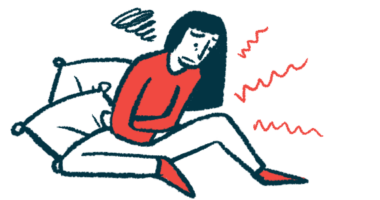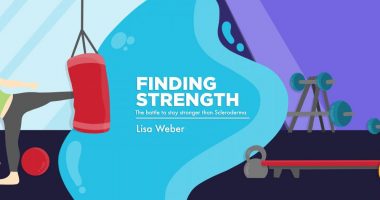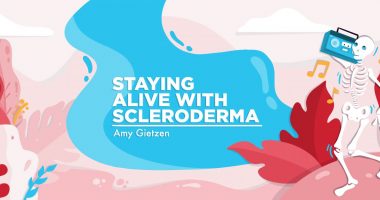Noninvasive vagus nerve stimulation can safely ease SSc pain
At-home therapy sends electrical stimulation to vagus nerve through outer ear

A noninvasive form of vagus nerve stimulation therapy may help safely reduce pain in people with systemic sclerosis (SSc), a small Italian study has found.
The technique, called transcutaneous auricular vagus nerve stimulation (tVNS), which involves electrical stimulation to the vagus nerve through the skin on the outer ear and can be done at home, also resulted in lower levels of IL-6, an inflammatory molecule with a known role in SSc.
The study, “Transcutaneous auricular branch vagal nerve stimulation as a non-invasive add-on therapeutic approach for pain in systemic sclerosis,” was conducted by researchers in Milan, Italy, and published in RMD Open.
About 4 in 5 scleroderma patients experience pain
SSc, or scleroderma, occurs when thick scar tissue builds up and replaces normal tissue. While scleroderma affects mainly the skin, its systemic form often affects many other parts of the body, including the lungs, the heart, and the muscles and joints.
About 4 in 5 people with scleroderma experience pain, mainly because of digital ulcers (open sores on the fingers or toes) and swollen joints. Pain makes regular activities harder and can also lead to sleep and mood problems.
Neuromodulation therapy such as vagus nerve stimulation works by delivering an electrical stimulus to a nerve that alters the way it communicates.
Earlier work has suggested that vagus nerve stimulation may help reduce pain and inflammation in autoimmune diseases such as lupus. The vagus nerve is a large nerve that runs from the brain and branches out to the neck, heart, lungs, and abdomen.
In the U.S., vagus nerve stimulation is approved for use in some people with epilepsy, in hard-to-treat depression, and in stroke rehabilitation.
To test how well tVNS may work for people with SSc who have moderate to severe pain, the researchers designed a controlled study. The study ran between March 2019 and January 2022, in part during the COVID-19 pandemic.
When they entered the study, patients were randomly assigned to one of two groups. All patients received the same two treatments: tVNS and a sham stimulation. However, the order in which they received the treatments was different.
One group received tVNS, followed by a four-week washout (rest) period, then the sham stimulation. The other group started off with the sham stimulation and received tVNS after the four-week washout period.
For tVNS, a structure similar to an earphone was placed on the left ear. A 25-Hz electrical stimulus was delivered in pulses from a neuromodulation device through two electrodes, or fine wires, to the vagus nerve.
Our data support the use of tVNS as a non-invasive tool for the treatment of chronic pain in patients with SSc, as well as in other systemic autoimmune diseases.
Patients used portable device at home for 4 hours per day for 1 month
The device was portable and patients performed the treatment or control stimulation at home for four hours each day for a total of four weeks, or about one month. For the sham stimulation, a 1-Hz electrical stimulus evoked the same tingling sensation as tVNS.
A total of 32 patients were initially assigned in the study, but 11 dropped out. Seven had to stop because of logistic challenges during the pandemic, three had trouble finding enough time for the treatment, and one was hospitalized.
Of the 21 patients who completed the study, 19 (90.5%) had limited SSc and two (9.5%) had diffuse SSc. Their mean age was 58 years, and most (85.7%) were women.
All kept taking their regular medications. Six (28.6%) were taking immunosuppressants, and 16 (76.2%) were on calcium channel blockers and low-dose aspirin to manage Raynaud’s phenomenon, where the fingers and toes feel numb and prickly.
Pain was assessed by asking patients to rate pain intensity in the previous week on a scale from 0 to 10, where 0 represents no pain and 10 represents the worst pain possible.
At baseline, or entry to the study, 11 patients had moderate pain, rated a 6 or 7 on the numeric scale. Ten patients had severe pain, rated an 8 or higher. The most common type of pain was joint pain (81%).
Five (23.8%) patients had active ulcers, four (19%) had recurring migraines, and two (9.5%) had fibromyalgia, a condition characterized by widespread pain accompanied by fatigue and problems with sleep, memory, and mood.
Seven (33.3%) patients had depressive symptoms, based on a score above 10 on a depression questionnaire called PHQ-9, and 13 (61.9%) had trouble sleeping, indicated by a score above 5 on the Pittsburgh Sleep Quality Index.
tVNS led to significantly greater reduction in pain
tVNS resulted in a significantly greater reduction of pain intensity compared to the sham stimulation, with a mean drop of 27.7% versus 7.7% from baseline, and more patients achieved a clinically relevant reduction of two points after tVNS than after the sham stimulation (13 vs. 5).
While other measures of quality of life did not improve after tVNS, “no significant side effects were reported,” so tVNS may be safe and effective in reducing pain in SSc, the researchers wrote.
On average, blood levels of IL-6 dropped by 17.1% after tVNS, whereas they increased by 39.6% after the sham stimulation.
“Our data support the use of tVNS as a non-invasive tool for the treatment of chronic pain in patients with SSc, as well as in other systemic autoimmune diseases,” the researchers concluded, adding that its effect on IL-6 should be investigated in a larger study.








